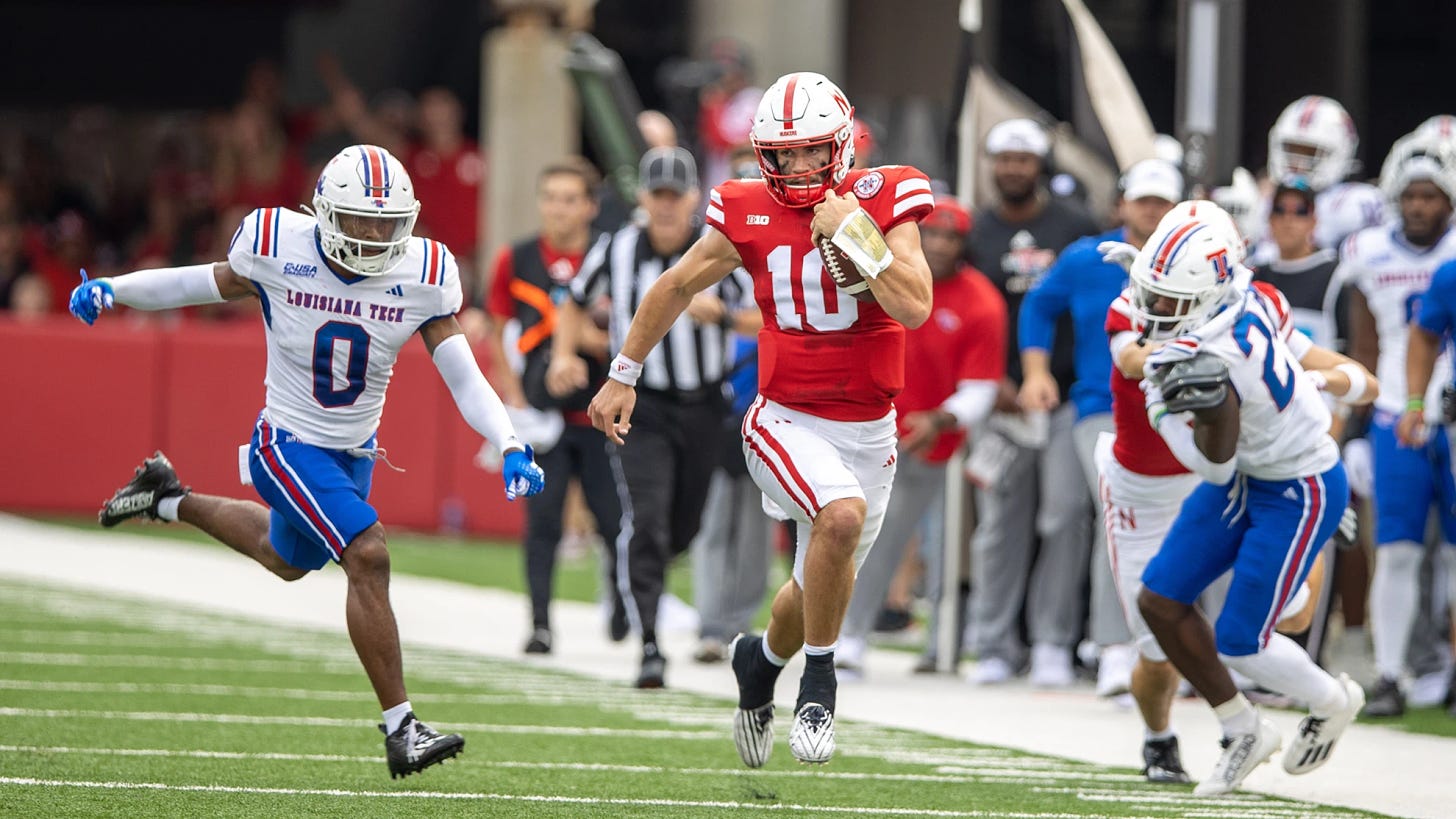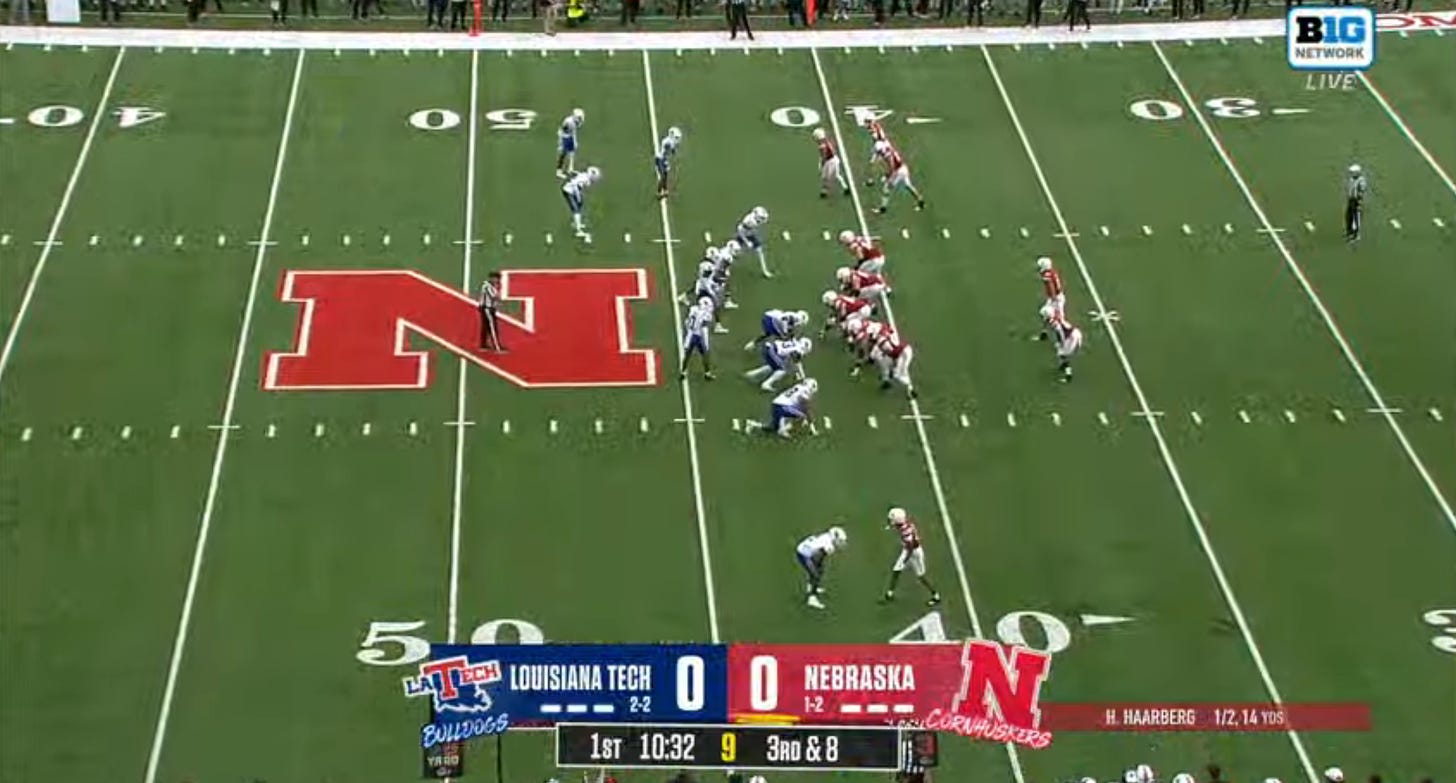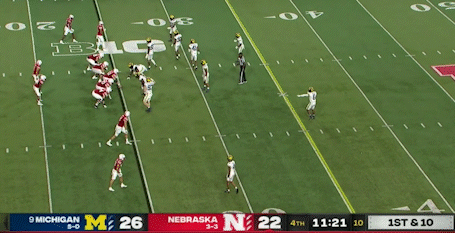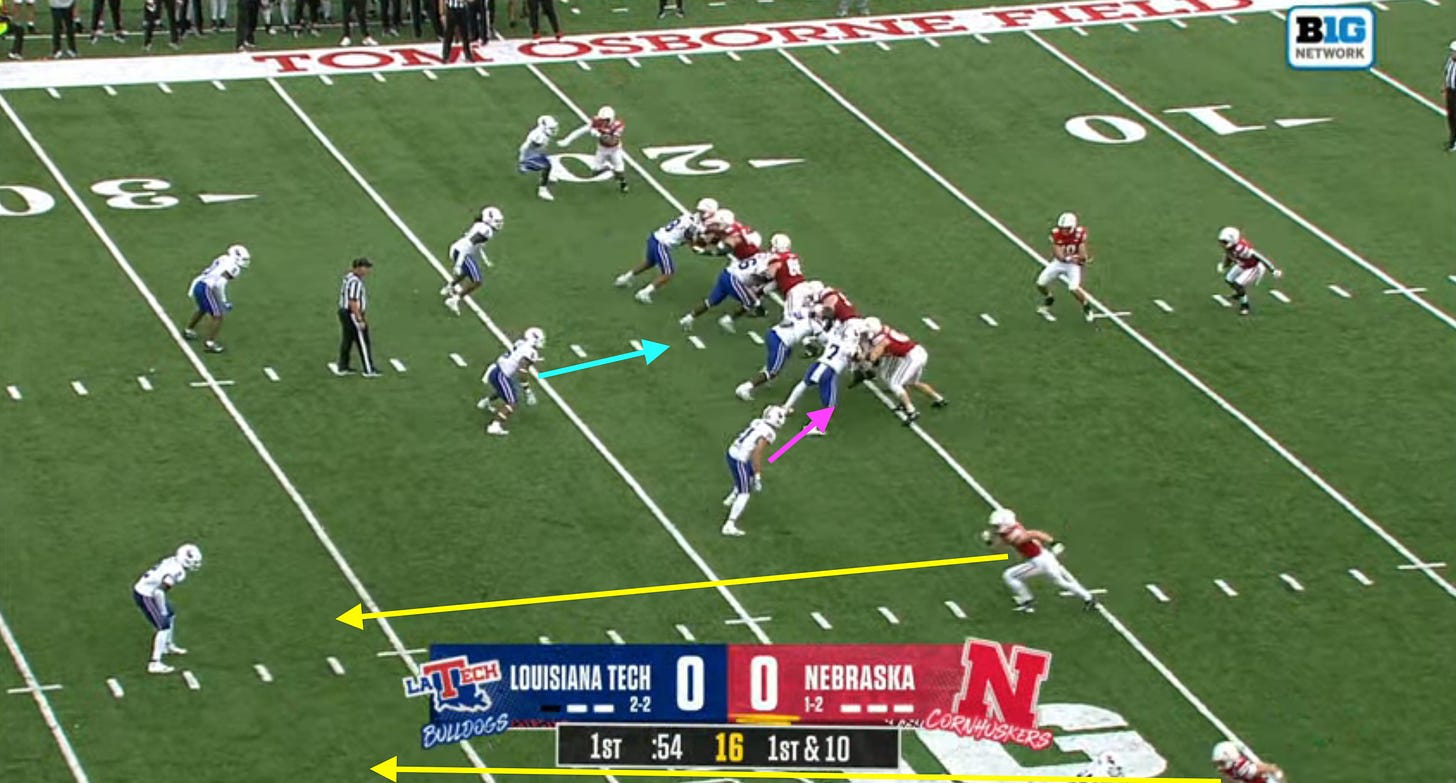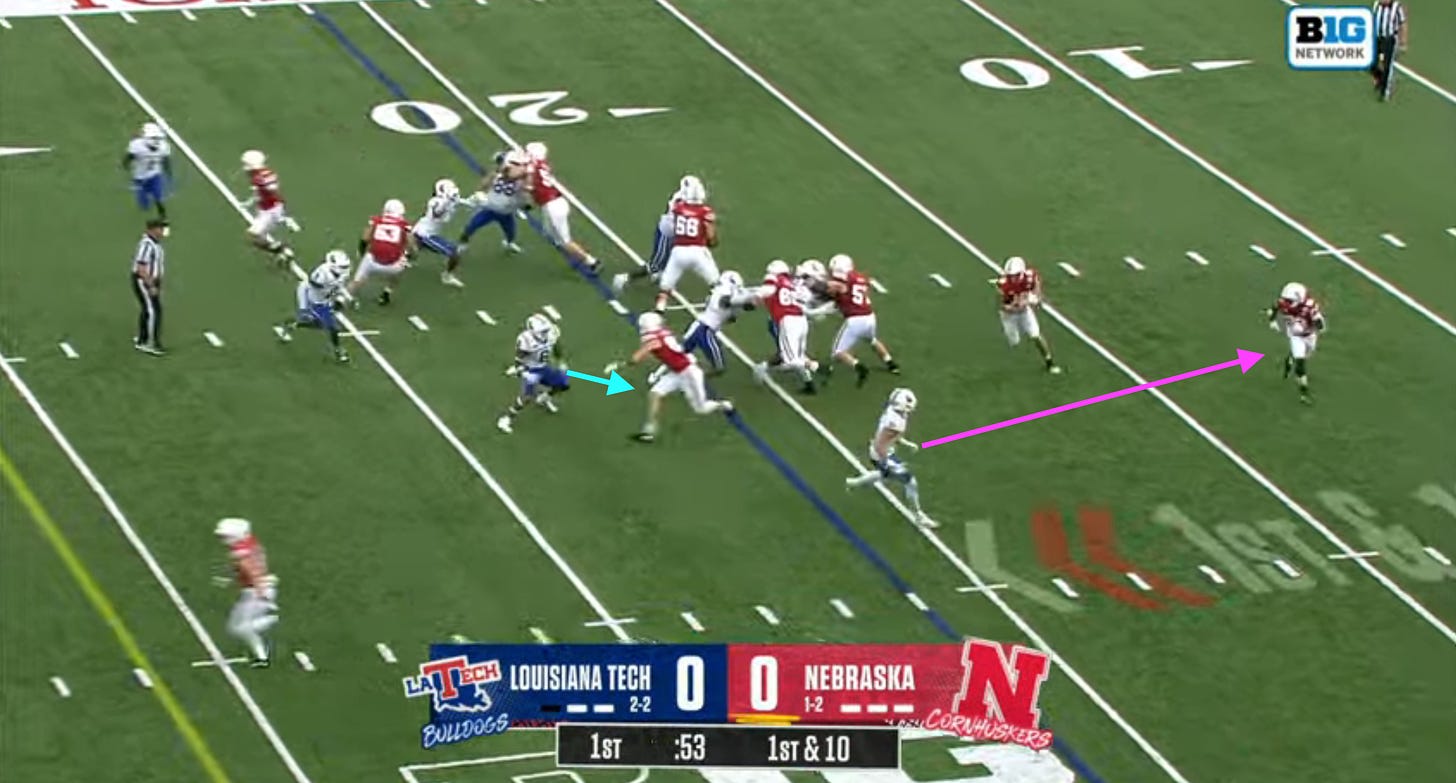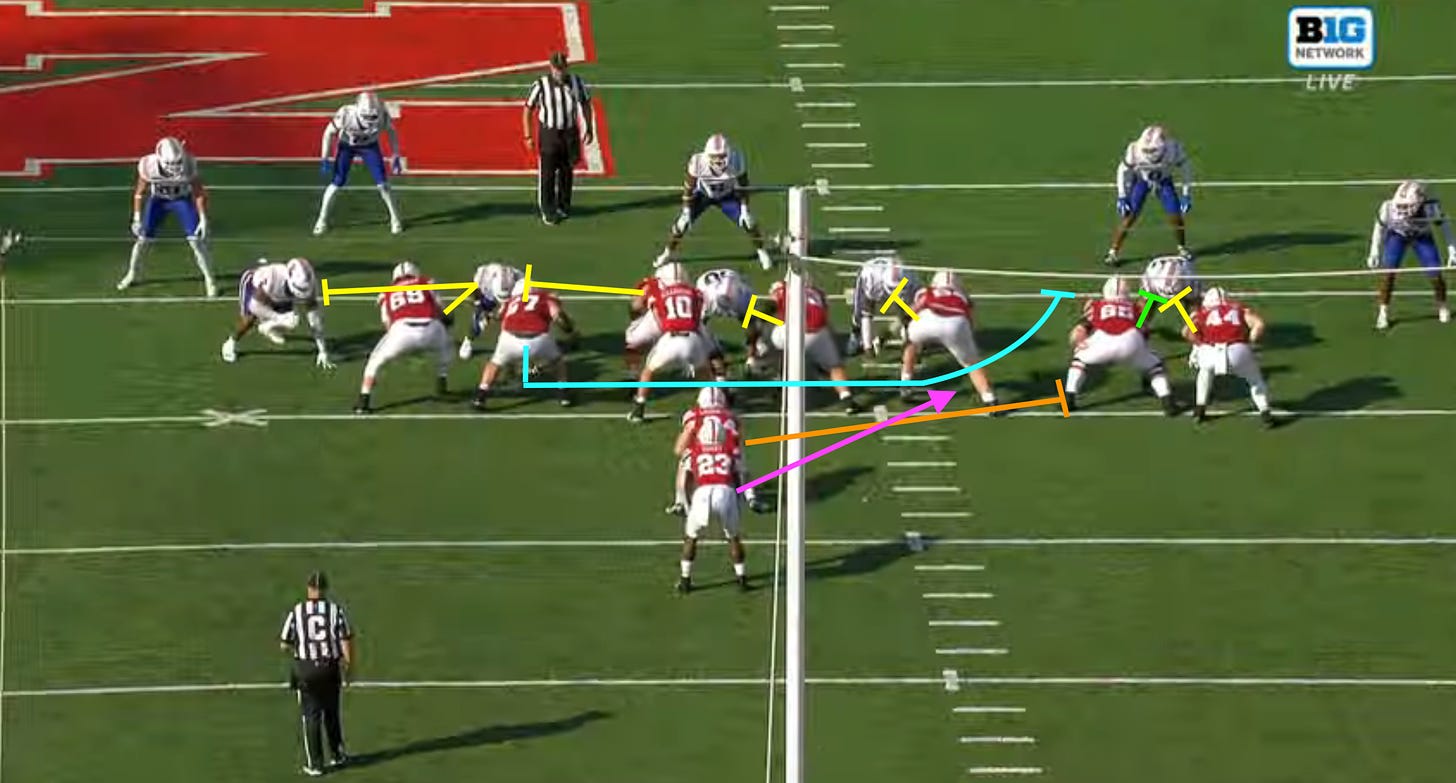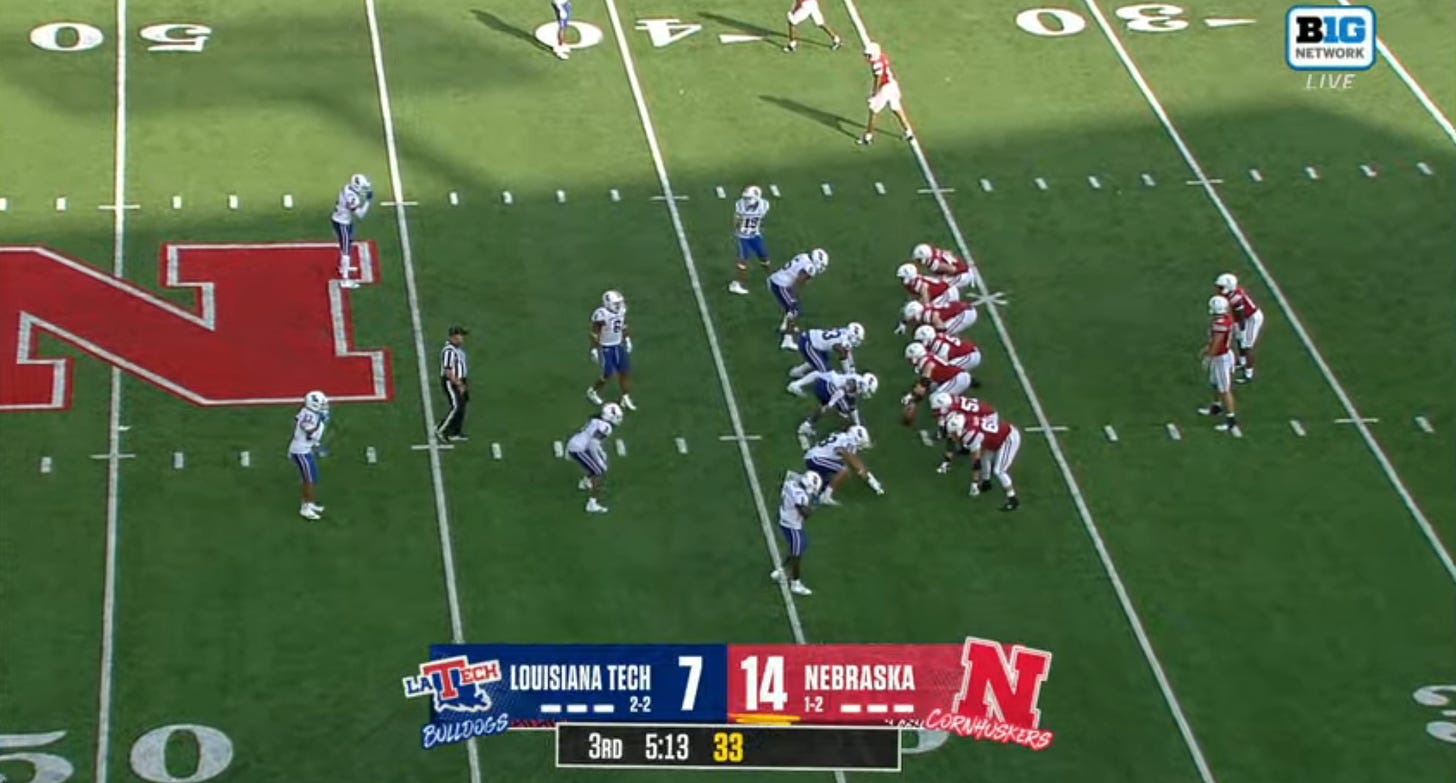OFFENSIVE RECAP: 2023 Louisiana Tech
Another young Husker quarterback goes nuts on the ground against a non-con opponent!
Glossary of Terms1
Link to Game Sheet2
DRIVE 1
6 Plays, 2.0 Yards Per Play
16.0% Success Rate
0 Explosive Plays, 1 Havoc Play Allowed
The game gets off to an inauspicious start when Nebraska calls a deep play-action shot on the first snap with eight in protection in an attempt to surprise Louisiana Tech out of the gates … and gives up a sack with the Bulldogs bringing six rushers:
This is an initial four-man rush, but two additional defenders in the middle of the formation also fire on the quarterback off the run fake. Running back Anthony Grant, in to protect with NU’s tight ends, manages to pick up one, but the two members of the right side of the Husker line doesn’t recognize it and both block one player while the Bulldogs rusher gets a free run at the quarterback for a sack. I don’t think this is a planned blitz; the two additional rushers don’t come right at the snap, and I think, instead, overcommit to the run fake and find themselves with an easy lane at the quarterback and just go for it instead of trying to recover into coverage. The Huskers offense would struggle with this level of aggressiveness from the Bulldogs front seven all day.
Nebraska gets a few yards back on an Inverted Veer play that isn’t well blocked to set up a long third down, then quarterback Heinrich Haarberg makes a nice second-reaction play to receiver Billy Kemp IV on a short whip route, with Kemp getting 7 great yards after catch to barely convert.
On the next first down, NU gets in heavy personnel with three tight ends on the field to run the Duo windback play it had success with against Colorado, but Louisiana Tech has eight men in the box and stuffs it. On second down, looking to take advantage of the aggressiveness the Bulldogs are playing with so far, coordinator Marcus Satterfield dials up a play-action boot play with a Y Cross action layering the tight ends across the field. The La. Tech safety here bites hard on the play fake and flies up on the run, but none of the three receivers out on the route has much separation, and Haarberg dirts it. Now in third and long, La. Tech comes out in a pressure package, with eight players along the line against an open formation and no safety deep:
A heavy blitz look like this would almost always have man coverage behind it, meaning Haarberg would need to get rid of the ball fast and be looking for one-on-one matchups. But at the snap, five of the defenders on the line drop into zone coverage, and one of the previously deep coverage players instead fills on the blitz:
Haarberg doesn’t see that it’s a simulated pressure and tries to take the ball deep on what he thinks is a one-on-one to Kemp — a good decision had he actually gotten man coverage — but with the Bulldogs actually dropping into a standard shell and playing a deep zone, he’s actually throwing into double coverage and nearly is intercepted. That’s a young player in their second start.
DRIVE 2
7 Plays, 4.4 Yards Per Play
42% Success Rate
0 Explosive Plays, 0 Havoc Plays Allowed
Backed up deep in Nebraska territory, this drive gets underway with a couple of nice keepers by Haarberg on run-option plays, the first on the Split Zone Arc concept it had success with in the opener with Jeff Sims and the second on a Load Option play out of the I formation. Haarberg reads these pitch concepts to the edges really well and has the speed to make defenses pay for leaving him, something we’ll see throughout the game.
Louisiana Tech was in light boxes on the first four snaps of this possession, and Satterfield tried to make them pay with an inside Split Zone running play, but poor blocking dooms it. Grant — now NU’s primary ball-carrier after injuries to Gabe Ervin and Rahmir Johnson — was better at zone concepts last year, and specifically split zone, because of his (pretty good) vision and ability to see cutback lanes. It will be interesting to watch if NU ups its zone-running usage over gap usage after the injuries.
Now in second and long, NU spreads it out and starts throwing, the first rep of which results in a nice completion on a slant to Kemp. Satterfield would elect to dropback pass on the next three plays. The first, a mirrored deep Slant/Flat play on first down, Haarberg pulls down for a one-yard scramble. That concept has been run five times this season and has yet to generate a successful play, and it has led to one interception. On second down, he calls his Stick concept with the No. 2 receiver running a wheel route, and Haarberg overthrows a ball to Kemp in the flat to the backside coming out of the backfield, an interesting personnel usage for the receiver. On third down, NU runs the same Flood concept out of the bunch formation that it did on the last third and long, with La. Tech in the exact same eight-down pressure look. Instead of doing the weird sim pressure with the safety, the Bulldogs run a more conventional defense and just drop out into coverage. Haarberg reads things a bit better this time, going to the backside receiver, Marcus Washington, on a curl, but the pass is dropped.
DRIVE 3
8 Plays, 8.6 Yards Per Play
62.5% Success Rate
1 Explosive Play, 2 Havoc Plays Allowed
The last drive got derailed by getting a little too pass-happy, but Nebraska kept the ball on the ground this possession, calling eight straight runs to get a score. It would have two drives Saturday of 8+ plays that were all runs and scored a touchdown. La. Tech used a light or standard box on 5 of 8 snaps on this drive and was playing two-deep safety shells throughout the first half at a high rate, (51.4% of first-half snaps) considering the Bulldogs were playing an extremely run-heavy team with a quarterback in their second start. Satterfield responded to these light alignments with 5 of the 8 snaps featuring a second tight end or fullback.
It also helps to get a 43-yard gain on the first play of the drive:
This run comes off a concept called Freeze Option. This was a play former coach Scott Frost ran a lot in 2021 with Adrian Martinez to some success:
This play functions a lot like you’re typical outside option play, with the quarterback reading an edge defender and pitching off of them. The difference is the initial movement in the backfield by the quarterback. The QB will give a token fake on an inside running play to the back before embarking on his option arc3:
NU’s offensive line is also zone blocking away from the direction the option will be run. These two combined influences make the La. Tech middle linebacker (blue arrow) and read edge defender (purple arrow) think it’s going to be an inside running play, keeping them “frozen” in the middle of the formation instead of flying to the edge, causing a half-second of hesitation for the offense to exploit.
This little freeze of the defenders gives Haarberg and Grant an advantage to beat the defenders to the edge, and the middle backer’s delay allows NU’s tight end Boerkircherto get in position to hook block him and eliminate him from the play. With NU’s two other trips receivers to the play side running their coverage defenders deep down the field (yellow arrows in the first diagram) it’s essentially now just the edge defender isolated with Haarberg and Grant, with Haarberg reading him to make whatever action he chooses wrong. The defender goes to Grant, and Haarberg beats the Bulldogs’ backside linebacker in a footrace down the field for a chunk gain:
Nebraska picked up another first down with gap-scheme runs on Counter and Duo. One thing to note here is that I believe it was Satterfield’s first use of non-end-of-play tempo this season, as NU didn’t huddle between these two plays. He would use tempo a couple other times this game, which is good to see. While I’m fine with huddling, ONLY huddling is just as nonsensical as never doing it, as good offenses use tempo as a weapon when it can give them an advantage. It’s nice to see he’s at least open to that.
Now inside the LTU 30-yard-line, NU comes out in unbalanced formations (both on-the-ball receivers to the same side of the formation) on two of its next three plays, one out of the I formation and another out of a shotgun quads alignment. NU didn’t utilize a single snap of quads (four eligible receivers to one side of the formation) or unbalanced in the first two games but has done it some since Haarberg entered the lineup. Both quads and unbalanced can create alignment and responsibility headaches for defenses, so it makes sense these are going to be part of the menu now that the offense is heading in a more option direction with Haarberg. The I formation unbalanced look leads to a successful toss play, but an Inside Zone-read action out of the quads formation that tries to split the two tight ends gets blown up.
On third and 3 inside the 20, Satterfield tries misdirection to convert with some fast backfield motion by corner Tommi Hill (lined up at receiver) to the field that turns into a sweep the other way to the boundary, but the play also gets stuffed because of poor run blocking and blown assignments. La. Tech wasn’t really using many heavy boxes or fronts early to stop the Husker run game; the Bulldogs were just winning one-on-one blocking matchups and shooting gaps. NU’s run blocking has been pretty solid so far this year — arguably the best part of the offense — but Saturday was a pretty weak effort against a Conference USA front that has been largely pushed around this year by worse teams. The Pipeline is going to have to be a lot better to play at all with Michigan.
But the Huskers get a second chance after a fake field goal conversion. After another Load Option play out of the I — one of the few unsuccessful edge option plays Saturday — Kemp takes an under-center Jet Sweep around the edge for a score:
Satterfield has used Jet motion on 30.8% of NU’s run or RPO snaps this early in this season as a way to influence linebackers or as misdirection, but he had yet to give the ball to the motion man, so it was a major tendency breaker. I’ve also mentioned several times how hard LTU was crashing down on inside runs early in the game, so the motion was a way to trigger their overaggressiveness to the middle of the formation, with the give outside going to an area of the field they weren’t expecting. There were also two great blocks at the second level by tight ends Thomas Fidone and Nate Boerkircher to spring the play into a touchdown.
DRIVE 4
6 Plays, 5.6 Yards Per Play
33.3% Success Rate
1 Explosive Play, 1 Havoc Play Allowed
NU used heavy personnel with multiple tight ends or fullbacks on the last five plays of the previous drive and continued the trend on Drive 4, using 12 personnel (one back and two tight ends) on its first five snaps. Ten straight snaps of heavy personnel!
Haarberg rips off a 75-yard touchdown on the Freeze Option play again, but the score was called back on a holding penalty, though still nets a 32-yard gain because of where the hold occurred.
Regardless of the penalty, at this point, you can kind of see the adjustments Satterfield is starting to make: After the first couple of drives, his focus has been on exploiting La. Tech’s aggressiveness to the middle of the formation by trying to use misdirection or hesitation inside and then actually running the ball to the edges. It was evident on the Jet Sweep touchdown on the last drive, and the little fake to the middle by the QB on the Freeze Option play was also meant to get those interior defenders to bite down to the inside, then run with numbers and optionality to the edge.
An Inside Zone/Glance RPO to the middle two snaps later also is part of this strategy keying on La. Tech’s aggressiveness:
This is a run-pass option, reading the two Louisiana Tech linebackers aligned behind the line. Haarberg has the option to hand the ball off to the back here if the linebackers stay deep in coverage, or he can pull it to throw the in-breaking route to slot receiver Alex Bullock with easy inside leverage (which he does) should the read linebacker collapse down on the run (which he does). Watch in the video how hard those two middle backers fly to the line of scrimmage when they see Haarberg put the ball in the back’s belly: This is the level of downhill play by the La. Tech defense the NU run game was dealing with all day. The blocking wasn’t great, but LTU was also very keyed into stuffing the line. This play was also a nice bit of ballhandling by Haarberg. He operates the pull really late; the back is already past him and he decisively pulls the ball out, resets his feet, and puts an accurate throw on Bullock.
But the drive comes undone on a 10-yard loss on a sack when NU tries to pull a linemen on an under-center play-action shot, but the Louisiana Tech d-lineman shoots in the gap before the other linemen can recover:
Satterfield probably thought he could generate a chunk play downfield here because the run had been working so well, but poor blocking (this time in pass pro) dooms the play.
Jeff Sims comes in for the next play after Haarberg had to leave because his helmet came off, and a miscommunication between he and the running back loses two more yards. One of these two players went the wrong way; impossible to know which. Haarberg comes back in and throws incomplete on third-and-22 to end the drive. This offense is just not built right now to lose 10 yards on a snap and survive.
DRIVE 5
8 Plays, 4.0 Yards Per Play
37.5% Success Rate
1 Explosive Play, 0 Havoc Plays Allowed
Nebraska starts this drive with only a few minutes left before halftime but comes out with three straight runs. The runs convert a first down, and the Huskers don’t huddle here to preserve some clock. From this point on, NU gets into spread formations and starts throwing, with Haarberg going 1-for-5, his only completion for 22 yards on a Four Verticals play where he hits Kemp on the hash in the open seam against Cover 3. The Big Ten Network camera is super zoomed in on the tackle box — I hate when games are broadcast on this channel — so it was hard to see any downfield routes or coverages, and I was mostly making informed guesses off the receivers stems or defensive backs tendencies. But I had La. Tech running Cover 3 on a 59.8% of its snaps Saturday, and Satterfield would go to Cover 3 beaters like Four Verts several times, including on the next play.
Haarberg doesn’t complete another pass and the drive runs out of time before the half, forcing a field goal attempt.
DRIVE 6
9 Plays, 9.4 Yards Per Play
66% Success Rate
3 Explosive Plays, 2 Havoc Plays Allowed
Power football! Starting the drive backed up inside its own 20, Nebraska runs the ball nine consecutive times to open the second half, goes straight down the field, and punches in the touchdown. Seven of the 9 plays on this drive came out of the I formation, with five of them featuring No. 3 tackle Teddy Prochazka as a sixth offensive lineman. That’s a commitment to a mindset, baby.
Satterfield begins this drive by working the edges, running the Toss play out of the unbalanced I-formation look for 14 yards and then a Load Option out of the same unbalanced I alignment for 8 yards. After a mishandled snap on the next down, though, he brings on the sixth offensive lineman and hammers the same exact play out of the same exact alignment on five of the next six snaps: Power.
Power is a classic gap-scheme run concept that every playbook has. One of the most physical concepts in football, it features one lineman pulling across the formation and typically has two double teams at the point of attack. This variation, with a fullback on the field, is often called Power-O.
Louisiana Tech is in a five-man shifted front, with three defensive linemen to NU’s weak side and just two defensive linemen to its strength, forcing the line to have to cover a lot of distance away and eliminating one of the double teams for this particular rep. Backside tackle Turner Corcoran puts a shoulder into the backside 3-technique lined up over Ethan Piper before pivoting to cut off his man on the edge, allowing center Ben Scott enough time to slide down and handle the 3-tech, while playside guard Nouredin Nouili slides down to take the man over Scott. Piper, meanwhile, in blue, is pulling to the other side of the formation, where Prochazka, with the green lines and wearing #85, works in a combo with the tight end next to him to create the “second” double team. Piper leads up in the hole and crushes the playside linebacker. Meanwhile, in the backfield, the fullback, orange, is leading to the edge to kick out the primary contain defender. This creates a huge hole in the C gap for Grant, who bursts through it. A well-run Power play always creates a one-on-one for the back in the hole with a linebacker or safety, which is exactly what happens. Grant hits him with a stiff arm, and it’s off to the races.
After the 34-yard gain, this same play out of the same formation gets Grant runs of 7 and 0 on the next two plays, and after a failed Haarberg keeper on the Split Zone Arc play, Grant busts a 19-yard run off Power O on fourth and 1, then converts a 2-yard touchdown with it to give NU a 14-7 lead. Five reps of Power on that drive went for a combined 62 yards, and 5 of the 7 reps NU ran it in the game were plays that resulted in a success. Overall on gap scheme runs, Nebraska was successful on nearly 65% of its gap-scheme runs Saturday, a season high.
DRIVE 7
6 Plays, 4.8 Yards Per Play
33% Success Rate
1 Explosive Play, 1 Havoc Play Allowed
After a drive in which the Huskers ran the ball all nine plays, Satterfield opens this possession with a hard play-action boot to try to get Louisiana Tech to bite. He brings the condensed receiver across the formation to form a three-level flood to the short side of the field with the tight end and the back. I can’t see any of the routes downfield,4 but Haarberg dinks it to the back for two yards.
On the next play is a long touchdown run from Grant on a Toss play that gets called back by another hold on the edge by a receiver. This is another unbalanced alignment, with the tight end to the same side as the receivers:
If you look to that side just before the snap, you can see the third in-line blocker to the right of the center and the two receivers. When the fullback goes to that side, too, NU now has thrown four blockers to that side of the formation. NU also ran this same play and formation on the first-half scoring drive for 8 yards and on the opening drive of the second half for 14 yards — all three reps of this short Toss were successful. Ifs and buts, but had those two receiver holds not been called, the Huskers pretty easily top 400 yards on the ground — no small feat against anyone.
Grant’s gained yardage before the penalty does make it second and short, and NU stays in four-to-a-side unbalanced for the next two snaps, looking to keep up its leverage advantage, though this time out of the quads shotgun look it had run previously:
The first is an Inside Zone that converts the first with a short run, with La. Tech bringing a corner blitz from the weak side. Satterfield goes with tempo and NU lines up fast in the same formation. The initial part of this play is the same Inside Zone look as the last play, but Haarberg pulls the ball on a play-action heavy-protection shot with eight people blocking and only two players out in routes. The bad news: La. Tech is doing something similar, too, with the corner blitz running right into the dropback and generating immediate pressure. I can’t really see the routes, but NU’s receivers seem to be running a “Smash” concept to that side, with a short route and a deep corner over top of it. Haarberg fumbles on the hit,5 but the ball is recovered by the offense.
On second and 9, Satterfield tries to hit the Cover 3 seam again with the same Four Verts play (La. Tech was in C3 on the final four snaps of this drive), but Haarberg goes to the inside breaker Fidone instead of the seam route. On third and long, Haarberg is able to hit Kemp on a whip route against pressure again from the Bulldogs, but Kemp’s RAC comes up a few yards short.
Instead of going for a fourth and 3 at about midfield, coach Matt Rhule elects to play field position and punt. I don’t necessarily disagree with the decision in this specific situation, but if NU is going to play this single-wing, quarterback-run style of offense, it’s going to generally need to be aggressive on fourth and shorts. One of the strengths of a QB-run or option offense is its ability to be efficient in short yardage; it’s why triple option teams so often lead the NCAA in conversion attempts. And without the consistent explosiveness of a strong passing game, you have to be willing to take more risks to keep your drives alive. Offense is just harder when you run this scheme, so you’ve gotta be more willing to go out on a ledge to ensure your successful possessions turn into points. And credit where it’s due: The fake field goal in the first half and the fourth and 1 conversion on the last drive were gutsy calls that paid off and exemplify the benefits of what I’m saying. Rhule clearly seems to value complementary football and protecting his strong defense, which I get and agree with, but that line of thinking can’t get too conservative, and it might have here. I’d have loved to see if our giant, fast quarterback could have picked up 3 yards here.
But back in the non-theoretical world, both drives that had long touchdown runs called back end in punts. That’s a tough break.
DRIVE 8
3 Plays, 11.0 Yards Per Play
33% Success Rate
1 Explosive Play, 0 Havoc Plays Allowed
NU’s complimentary/field position football pays off, with the offense getting to start with the ball in Louisiana Tech territory after the defense keeps them pinned deep. Louisiana Tech had given NU light boxes on 4 of 6 plays on the previous drive, so Satterfield brings back the six-lineman I-Formation Power play on first down, which gets stuffed for a short gain when La. Tech sends a weakside blitz. The Bulldogs had blitzed just a handful of times in the first half but are getting run on now, so their pressure is increasing, with blitzes on 4 of the last 5 plays.
But a personal foul gets NU closer, and after another short run, Satterfield finally catches the Bulldogs for their aggressive run looks with a big play for a touchdown:
Nebraska is in a trips alignment with Boerkircher on the line attached to the boundary and Fidone on the wing to the field/trips side. The Bulldogs come with a late blitz here, bringing six rushers. The real star of this play is the blocking, as the line and Grant pass off defenders and stymie the rush to give Haarberg a clean pocket. LTU is playing Cover 3 behind the pressure, meaning three deep coverage defenders each responsible for a third of the field. Boerkircher runs straight downfield, taking the boundary deep defender with him, running him out of the play. Fidone, meanwhile, is coming on a Y Cross to the short side of the field, entering the zone where the deep defender just vacated. The middle linebacker is responsible for dropping to cover crossers, but the backer is staying near the line and standing on the hash flat-footed as Fidone runs behind them. The MLB can’t recover in time to make the play, and a couple nice downfield blocks spring it into a touchdown.
DRIVE 9
3 Plays, 27.3 Yards Per Play
100% Success Rate
1 Explosive Play, 0 Havoc Plays Allowed
Aren’t big plays great? NU picks up an initial first down on the heavy I Formation/six offensive linemen alignment they’ve been pounding in the second half, one on an Outside Zone (all the previous run plays had been Power) and the other on the Power O play again. Nebraska then spreads it out in an open doubles shotgun look, and Haarberg houses another Freeze Option from 72 yards out after breaking a tackle. NU had previously only run this play out of trips formations, so running it out of a doubles formation was new.
Overall, NU ran the Freeze or Load Option looks eight times on Saturday, which went for 166 combined yards (20.75 yards per play) and six were successful plays (75% success rate). And it would have been more yardage without that second-quarter holding penalty. Michigan will probably be a tougher test for this run game strategy from the past two weeks, but the Huskers were absolutely dominant with this concept Saturday. It reminded me of the opening stretch Taylor Martinez had with the Inverted Veer early in the 2010 season before Big 12 teams adjusted — fitting considering T-Magic was back on the sidelines to watch the game Saturday.
DRIVE 10
3 Plays, 1.0 Yard Per Play
0% Success Rate
0 Explosive Plays, 1 Havoc Play Allowed
With the game well in hand, NU just tries to get some game reps for younger players. Freshman back Emmett Johnson, now the No. 2 ball carrier with the injuries to Ervin and Rahmir Johnson, takes a counter for 3 yards on first down. Freshmen receivers Jaylen Lloyd and Malachi Coleman were also in on this drive. On second down, Satterfield again tries the play-action Smash concept out of quads in heavy protection, and Haarberg takes a sack. NU ran that play twice Saturday and both were sacks. There just aren’t enough options for the quarterback with only two players out in routes, and if both are covered he’s either scrambling or taking a sack. And the two-tight-end quads formation the Huskers ran that play out of got four reps Saturday, three of which were havoc plays for the defense. Let’s hit the practice field on those concepts before we bust them out in a game again. On third down, Kemp takes a tunnel screen that’s actually really well executed for a nice gain, but it’s hard to convert on third-and-14. The game is delayed for lightning after this drive and my TV didn’t record the rest, so I’m counting the remainder of the game as garbage time. GBR.
Yards Per Play measures how many non-penalty yards NU gained on a possession divided by its non-penalty snaps, a measure of its efficiency. Success Rate measures how often an NU play gained 50% or more of the yards it needed on a first down, 70% or more of the yards it needed on second down, or 100% or more of the yards it needed on third or fourth down. An Explosive Play is any designed run that gains more than 12 yards and any designed pass that gains more than 16 yards. A Havoc Play Allowed is any tackle for loss, sack, fumble, interception, pass break-up or batted ball NU allows.
In the 2021 clip, Martinez fakes the complete other direction.
This Big Ten Network cameraperson loves to zoom in on the tackle box after the snap.
NU’s fumble luck positively regressed Saturday after the unlucky Colorado game, with the Huskers fumbling three times Saturday and recovering them all.





